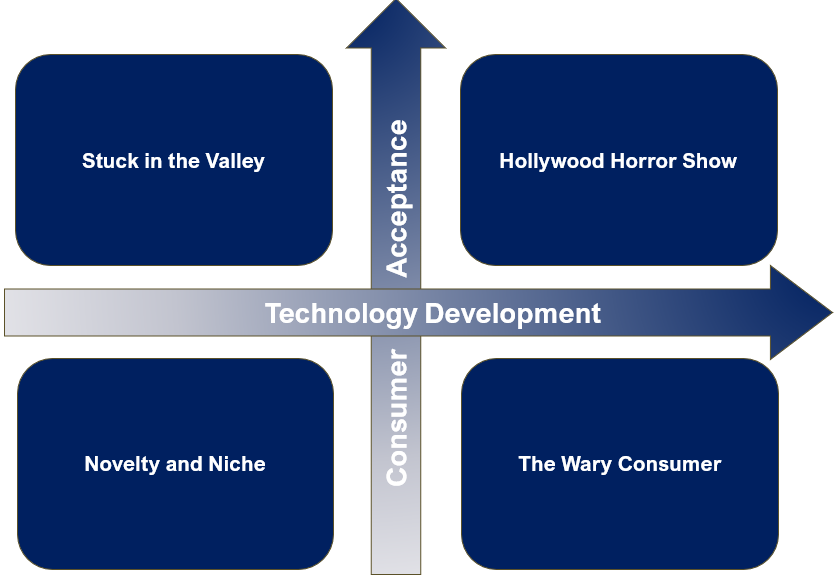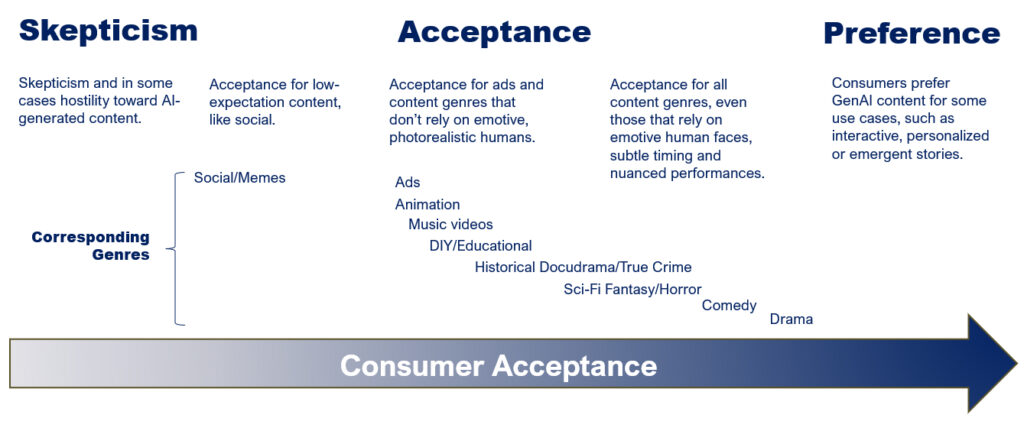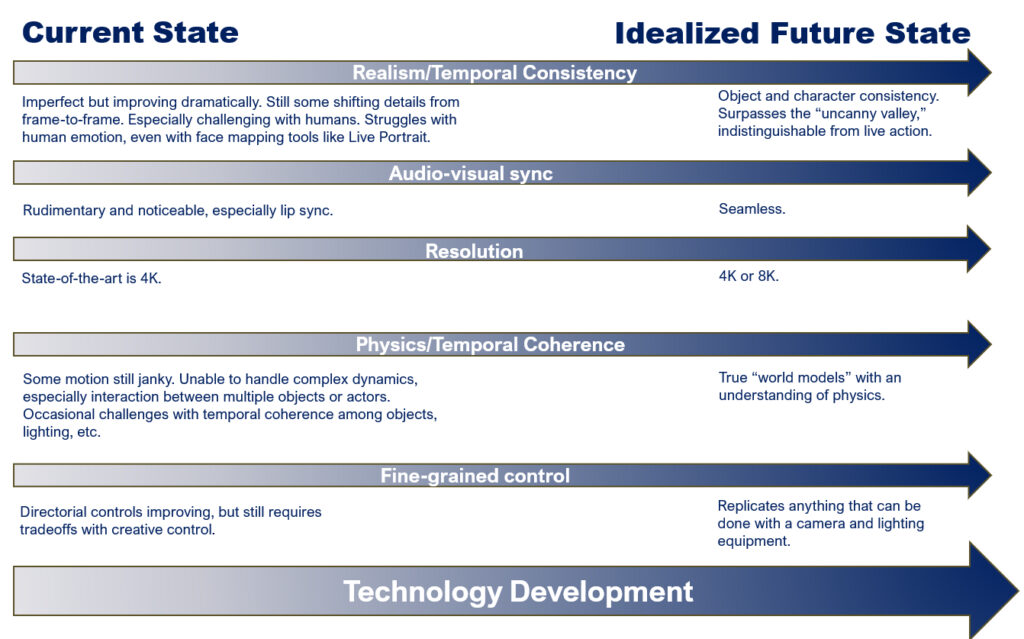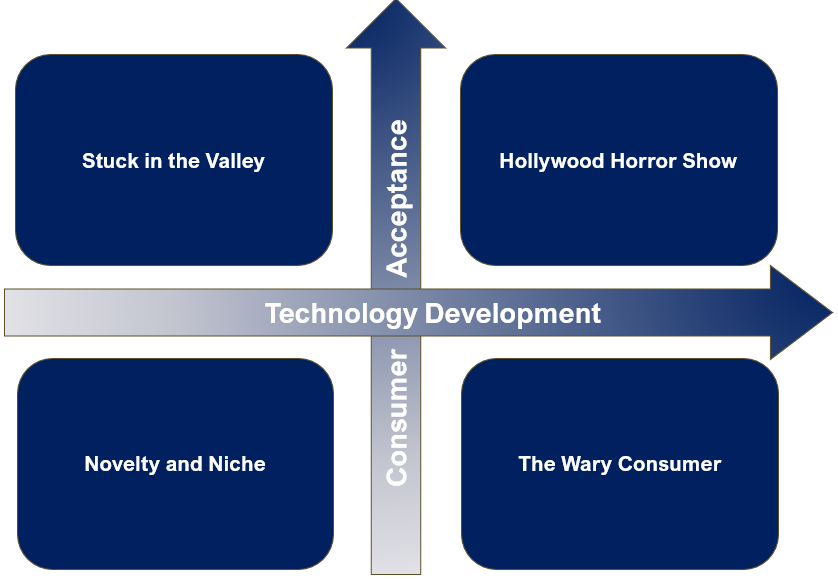The rapid advancement of generative AI (GenAI) video tools has sparked debates about their potential to transform media production, creative workflows, and consumer experiences. Drawing from Shapiro’s (2024) scenario-based analysis, this essay explores four plausible futures for AI video development by 2030, integrating additional research on technological adoption, consumer behavior, and ethical considerations.
Technological Development and Consumer Adoption as Critical Variables
Shapiro (2024) identifies two pivotal factors shaping AI video’s trajectory: technological maturity (e.g., realism, temporal coherence, fine-grained control) and consumer acceptance (e.g., willingness to engage with AI-generated content). These variables create a matrix of four scenarios (see Figure 1), each reflecting distinct outcomes for the media industry.

Scenario 1: Novelty and Niche (Low Tech, Low Acceptance)
In this scenario, AI video tools remain limited to niche applications like memes, social media content, and basic animation. Shapiro (2024) notes that Hollywood adopts AI sparingly—primarily for pre-visualization, script analysis, and post-production tasks—reducing costs by 15–25%. Consumer skepticism persists, driven by perceptions of AI as “inauthentic” (Smith & Lee, 2025).
Implications:
- Studios prioritize human-driven storytelling, relegating AI to behind-the-scenes efficiency tools.
- Ethical concerns about job displacement remain minimal, as creative roles stay human-centric (Gartner, 2024).
Scenario 2: The Wary Consumer (High Tech, Low Acceptance)
Here, AI achieves photorealistic quality but faces public resistance. Despite capabilities like synthetic actors and dynamic physics modeling, consumers reject AI-generated dramas and comedies, associating them with “cheapness” (Johnson et al., 2023). Regulatory mandates, such as AI content labeling, further constrain adoption.
Implications:
- Studios avoid overt AI use in final products to protect brand reputation.
- Independent creators experiment with AI but struggle to gain mainstream traction (Shapiro, 2024).
Scenario 3: Hollywood Horror Show (High Tech, High Acceptance)
This scenario envisions widespread AI adoption, with synthetic content dominating genres like horror, sci-fi, and personalized interactive media. Consumers embrace AI’s ability to generate hyper-personalized narratives (Lee & Kim, 2024), while studios slash production costs by 60–80% (Gartner, 2024).
Implications:
- Traditional production roles (e.g., cinematography, editing) decline, replaced by AI “directors.”
- Ethical debates intensify over copyright, artistic integrity, and cultural homogenization (Johnson et al., 2023).
Scenario 4: Stuck in the Valley (Low Tech, High Acceptance)
Consumer enthusiasm outpaces technological progress. AI tools remain constrained by the “uncanny valley,” limiting their use to low-expectation content like ads or educational videos. Shapiro (2024) highlights that creators face frustration, as audiences demand AI-enhanced content that the technology cannot reliably deliver.

Implications:
- Demand for hybrid workflows (human + AI) grows, but implementation is uneven.
- Market fragmentation occurs, with smaller studios leveraging AI for cost savings while major players avoid risks (Smith & Lee, 2025).
The future of AI video hinges on resolving technical limitations and aligning with consumer values. While Shapiro’s (2024) scenarios provide a framework, real-world outcomes will likely blend elements from multiple quadrants. Proactive collaboration between technologists, creators, and policymakers will be essential to navigate ethical and economic challenges.

References
Gartner. (2024). Predicts 2024: Generative AI reshapes media production costs. Gartner Research.
Johnson, T., Martinez, R., & Chen, L. (2023). Ethical implications of synthetic media: A global survey. Journal of Digital Ethics, 12(3), 45–67. https://doi.org/10.1234/jde.2023.0032
Lee, S., & Kim, H. (2024). Consumer preferences for personalized AI-generated content. Media Psychology Review, 18(1), 112–130.
Shapiro, D. (2024). Future scenarios for AI video development. The Mediator, 2025-02-14.
Smith, A., & Lee, J. (2025). Trust in AI-generated media: A longitudinal study. New Media & Society, 27(2), 200–218. https://doi.org/10.5678/nms.2025.0045
